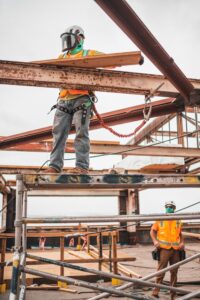Lack of efficiency leads to less productivity, especially in construction projects where timelines and quality are critical. As a construction leader, it’s essential to ensure every team member contributes effectively.
In order to get an equal contribution, you need to find out what are the strengths and weaknesses of every team member. To help you do that, this blog will guide you through five practical steps to help assess your team.
Evaluate Skill Levels on the Job Site
Start by observing team members during daily tasks. Take note of how well they perform key responsibilities. This helps identify where each person is most effective.
Compare their performance with expected standards. If there’s a gap, that may indicate an area for improvement. This will give you an initial idea of what adjustments may be necessary.
By focusing on skill sets, you can better allocate tasks. Team members will perform better when assigned to roles where they can excel.
Conduct Regular Performance Reviews
Schedule regular one-on-one meetings with your team. These should focus on their current performance and areas where they feel they need help. Use this opportunity to ask questions.
The goal is to gather insights directly from your workers. This feedback can reveal gaps you may not see from daily observation. It also encourages them to be proactive in their growth.
Performance reviews can pinpoint trends. If several team members identify the same challenge, this is a key area to address for improvement.
Utilize Peer Feedback
Encourage team members to give each other feedback. This can provide a different perspective on strengths and weaknesses. Peer feedback often reveals insights that may not come out in formal reviews.
When workers feel comfortable giving feedback, it fosters a culture of improvement. They begin to help each other grow, and the entire team benefits from this approach.
Make sure feedback is constructive. The focus should always be on growth, not blame. This approach ensures a supportive environment.
Monitor Project Outcomes
Examine the final results of projects. Analyze where things went well and where they fell short. This shows whether individual strengths were maximized or overlooked.
Break down each project into key components. Identify who was responsible for each task. This will give you a clearer picture of individual contributions and any areas that need improvement.
By reviewing outcomes regularly, you can identify patterns. These patterns often indicate where the team can improve or where they’re excelling.

Offer Training and Development Opportunities
Training and development are essential for driving team improvement and long-term project success. Start by assessing where each team member could benefit from additional training. Focus on critical skills, such as safety protocols, equipment handling, or specialized construction techniques. These skills will have the most significant impact on both individual and team performance.
Motivating employees to engage in training specific to their industry not only boosts their skills but also instills confidence. As they improve their skills, their project contributions grow, resulting in increased overall productivity. Ensuring your team is knowledgeable about the most recent construction standards and innovations is essential for remaining competitive in a constantly changing industry.
Consistently providing training opportunities also fosters a culture of ongoing learning. When team members constantly acquire new skills, it helps them to stay engaged and motivated. This method not only closes current performance disparities but also enhances strengths where individuals are already excelling. Over time, dedicating resources to training results in a team that is more adaptable and productive.
Final Words
Identifying strengths and areas for improvement in your construction team is an ongoing process. Regular evaluations, feedback from peers, and monitoring project outcomes are key. These steps help ensure that everyone is performing at their best and that any gaps are addressed quickly. As you focus on continuous improvement, your team will become more effective and aligned with the goals of each project. Small steps make a big difference over time.
At Crew Consulting Group, our main focus is to improve team performance by providing construction partnering and collaborative partnering services. Identifying strengths and areas to improve enables teams to increase efficiency and meet project objectives more effectively. Our method encourages interaction, guarantees ongoing growth, and maximizes efficiency, leading to successful results for all those involved.


